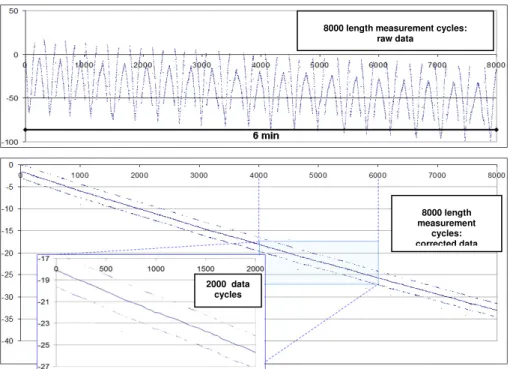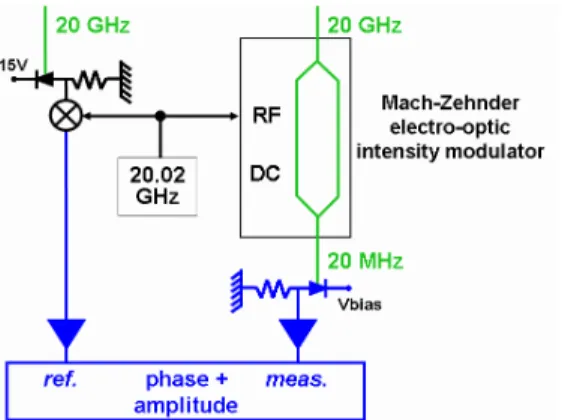HAL Id: hal-00914385
https://hal.archives-ouvertes.fr/hal-00914385
Submitted on 12 Dec 2013HAL is a multi-disciplinary open access archive for the deposit and dissemination of sci-entific research documents, whether they are pub-lished or not. The documents may come from teaching and research institutions in France or abroad, or from public or private research centers.
L’archive ouverte pluridisciplinaire HAL, est destinée au dépôt et à la diffusion de documents scientifiques de niveau recherche, publiés ou non, émanant des établissements d’enseignement et de recherche français ou étrangers, des laboratoires publics ou privés.
Long distance absolute laser ranging at the nanometer
precision level: the two-mode interference measurement
in the Iliade rangemeter
Ha Phung, Clément Courde, Alain Brillet, Christophe Alexandre, Michel Lintz
To cite this version:
Ha Phung, Clément Courde, Alain Brillet, Christophe Alexandre, Michel Lintz. Long distance absolute laser ranging at the nanometer precision level: the two-mode interference measurement in the Iliade rangemeter. Q2C6 From Quantum to Cosmos, Oct 2013, Nice, France. �hal-00914385�
Long distance absolute laser ranging at the nanometer precision level: the two-mode interference measurement in the Iliade rangemeter
Duy-Hà PHUNG, Clément COURDE, Alain BRILLET and Michel LINTZ (1)
Département ARTEMIS, UNS, Observatoire de la Cote d'Azur et CNRS, Nice, France
Christophe ALEXANDRE
Laboratoire CEDRIC/LAETITIA, CNAM, Paris, France
Some measurement schemes have been proposed and realized for the absolute measurement of long distances with an accuracy better than 10 nm. Published measurement setups (2,3) use one or even two laser frequency combs. As stated in (3), "significant engineering will be required to space qualify such a system". Simple methods, less technology-demanding would be valuable in the perspective of embedded instrumentation.
We have designed and implemented a two-mode interference measurement scheme that allows sub-nanometer scale resolution in long distance measurement. The two-mode interference signal contains both
- (sub-µm) interferometric information: the scale is the optical wavelength
λ
opt- (sub-15mm) modulation phase information: the scale is the "synthetic wavelength" corresponding to the frequency of the beat-note of the two modes: Λ ≡c/F .
With the addition of a time-of-flight (ToF) measurement, the method allows to combine the three data (ToF, synthetic wavelength and interferometric) in a single, high-resolution, high accuracy length measurement, obtained every 50 ms (4). A measurement update rate of 100 µs is possible, but may rely on the availability of significantly higher data processing rates in the FPGA phase-meter.
Implementation of this scheme has required that systematic errors on the phase and amplitude of the microwave optical signal be kept at a level well below 10-4 cycle and 10-4, respectively. One consequence of this requirement is the replacement of any parallel optics in the optical setup by wedged optics, so that multiple reflections do not interfere with the measurement and reference beams to better than 10-8 in optical power.
Fig. 1. Left: Schematic diagram of the telemeter. (P)BS: (polarizing) beam splitter. Right: the two-mode interference signal, plotted in the complex plane, calculated with the assumption that the ratio of the synthetic to optical wavelength is 20.
The range meter uses a Mach-Zehnder interferometer, the long arm of the interferometer being the path to the target.
1
michel.lintz@oca.eu
2
Y. Salvade, N. Schuhler, S. Leveque, S. Le Floch, "High-accuracy absolute distance measurement using frequency comb referenced multiwavelength source" Applied Optics vol 47 (2008) 2715-2720
3
I. Coddington, W. C. Swann, L. Nenadovic, N. Newbury, "rapid and precise absolute distance measurements at long range", Nature Photonics vol 3 (2009) 351-356
4
D.H. Phung, C. Alexandre and M. Lintz, "Two-mode interference measurement for nanometer accuracy absolute ranging", Optics Letters vol 38 (2013) 281-283
Figure 2.The two-mode interference signal, plotted in the complex plane, while the target is translated by about 7.5mm. Each "spike" of the signal corresponds to a fringe of the optical interference. The whole pattern corresponds to 104 spikes. In the above recording the data transfer was too low, so that during the transfer some
of the spikes could not be recorded (white areas). Present day's transfer system is much faster (UDP-IP).
A procedure, in which the optical frequency is shifted by FSR/4, then by FSR/2 (where FSR is the free spectral range of the interfereometer, determined from Time-of-Flight measurements) is used to record and exploit three successive measurements of the two-mode interference signal. The signal is complex, but with a very specific signature, which allows to identify systematic errors.
Figure 3. Length data retreived when translating slowly the target, by 30µm in 6 minutes.: Top: raw data. Down: with data processed to correct for the amplitude-to-phase coupling, see below.
Systematic errors of electronic origin are more difficult to deal with because the amplitude-to-phase (AM-to-PM) couplings effects at 20 GHz appear to have, not only an instantaneous contribution, but also a transient contribution. This contribution, related to the heating of the photodiode junction under the dissipated Joule power (5), exceeds the limit of 10-4 cycle by roughly two orders of magnitude. This
5
D.H. Phung, M. Merzougui, C. Alexandre and M. Lintz, "Dynamics of the Amplitude-to-Phase Coupling in 1.5µm High Bandwidth Photodiodes" submitted to Measurement Science and Technology
8000 length measurement cycles: raw data 8000 length measurement cycles: corrected data 2000 data cycles
thermal behaviour is not purely exponential with time and cannot be accurately corrected for (see, fig. 3, the residual errors observable on the length measurements).
Finally, we have suppressed, by 3 orders of magnitude, the AM-to-PM coupling effect by modifying the detection scheme of the 20 GHz beatnote. A Mach-Zehnder-type intensity modulator was used to achieve frequency conversion before the photodiode. In this way the AM-to-PM coupling is reduced by the ratio of the microwave-to-intermediate frequencies, i.e. 20GHZ / 20MHz = 103. This appears to be a satisfactory solution to reduce all kinds of AM-to-PM couplings, as well as reducing the cross-talks by about 20dB (5). This last point is important, not only for the range meter presented, but also for in high accuracy and low phase noise microwave optical links.
Fig. 4: Setup for implementation of the optical demodulation of the microwave signals. The left part (reference channel, with constant level, does not need optical demodulation, as AM-to-PM is very small). The right channel (measurement signal) undergoes optical demodulation before the photodiode. The photodiode detects a 20 MHz
(intermediate frequency) signal, where the time lag of ≈hundreds of fs associated to the variations of the optical power in the measurement photodiode, amounts to several 10-5 radians, a systematic errors which is acceptable
for the ranging measurements to retrieve the correct distance value.
With the implementation of optical demodulation, the Iliade range meter appears capable of nanometer-scale accuracy, and picometer scale resolution, absolute distance measurements.


